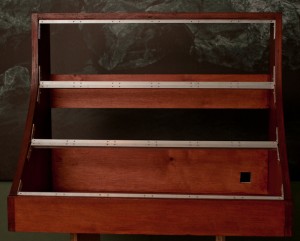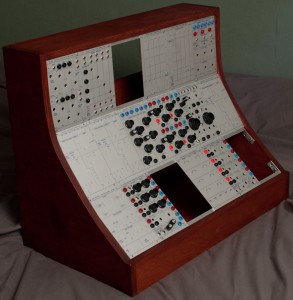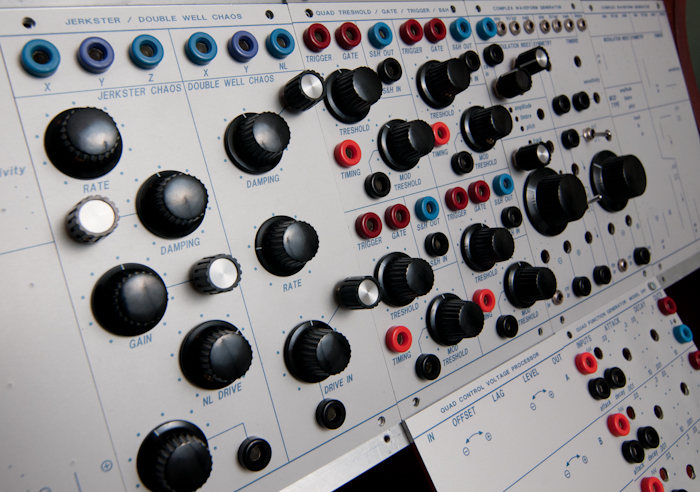I’ve been working on my new Buchla inspired modular on and off for some time now and finally had some front panels made. They turned out great and it inspired me to put some more energy into getting the modular done.
 I already finished the cabinet and rails for mounting the panels six months ago. So, last week I finally drilled the neccesary holes, threaded them and installed them in the encosure.
I already finished the cabinet and rails for mounting the panels six months ago. So, last week I finally drilled the neccesary holes, threaded them and installed them in the encosure.
To do: installing the power supply and internal wiring.
 Then I drilled the holes in the front panels so I could install them to the rails. Everything fitted perfectly as you can see in the picture to the right. Initially I wanted to go for the Buchla 200e look but the knobs needed for that are hard to source in small quantities so eventually I decided to use the black Davies knobs for the vintage Buchla 100 look.
Then I drilled the holes in the front panels so I could install them to the rails. Everything fitted perfectly as you can see in the picture to the right. Initially I wanted to go for the Buchla 200e look but the knobs needed for that are hard to source in small quantities so eventually I decided to use the black Davies knobs for the vintage Buchla 100 look.
I will be adding more detailed descriptions of my Buchla project in the SDIY section of my website soon. To finish this preview a closeup of some of the modules.
You can read more about this is the Buchlaesque SDIY section of this website.


Comments
5 responses to “Buchlaesque modular in progress”
Your cabinet, as well as the modules you have made, look absolutely awesome! I can’t wait to see the finished product.
BTW, where did you find those black, vintage-looking Davies knobs? Although I’ve found several sources of Davies knobs for Serge synths, I can’t seem to find the knobs for Buchla synths anywhere. Do you know if these knobs have a special name or perhaps a model number that I can reference them to?
Like you, I also have a MOTM modular. Within the next 6 months or so, I plan to build at least 15 modules that will either be identical to or very similar to Buchla 100 & 200 Series modules. But right now, I can’t make up my mind whether to modify these Buchla modules so they will interface with my MOTM modular, or whether to build a brand new Buchlasque modular synth that will contain clones or near clones of various Buchla modules.
Of course, if I do decide to build a 2nd modular synth that is strictly dedicated to Buchla-type modules, I will probably change the look of my front panels from my current all-black, MOTM-type format to a front panel style that closely resembles Buchla 100 and/or Buchla 200 modules. This means I’ll probably switch from all 1/4″ jacks to a mixture of banana jacks (for control voltages) and either Tini-D or 1/8″ jacks for audio signals. However, there is also a good chance that I may use 1/4″ jacks for the audio inputs and outputs since they are much more robust than 1/8″ jacks. (I also like to use 1/4″ switching jacks for normalized inputs and outputs.)
It looks like you have already dealt with these questions. You decided to build a 2nd modular synth that looks almost identical to a vintage Buchla modular. May I ask what finally convinced you to go this way?
Thanks!
I bought the black Davies knobs at Mouser. The big knob is type 1600BM (Mouser part no 5164-1600BM), the smaller one is 1610AA (Mouser part no 5164-1610AA). There are also clones of the Davies knobs available.
At first I wanted to built my Buchlaesque modular with the Buchla 200 or 200e look which I really like but the knobs needed for that are a bit hard to source in small quantities so I decided to go for the vintage Buchla 100 look as the Davies knobs are easy to source.
I decided for this Buchla modular as I really like the way Don Buchla designed his modules. They offer lots of functionality in one module. The fact that this modular is a lot more compact than a MOTM modular also appealed to me as my studio is rather small and doesn’t allow for more full sized MOTM stuff in there 😉
Thanks for the info, Andre! I’ll be checking back from time to time to see the finished product! Good luck!
A silly question.
Who was the manufacturer of the front panels?
Looks awesome!
The panels were made by a local Dutch company, specializing in printing on Aluminium. I’m sure you can find some company doing the same local to you.
However, it probably is expensive to do this for just one panel. I think I had 20 or 30 panels made (for myself and a couple of other synth builders) so the price per panel was much lower.